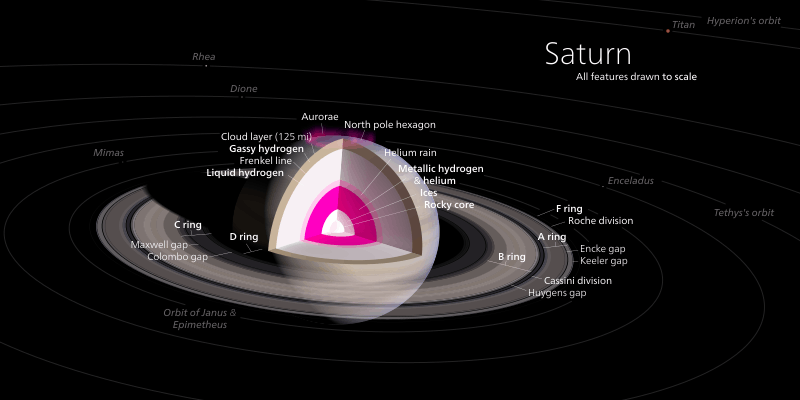Saturn Atmospheric Entry Probe
The Saturn Atmospheric Entry Probe is a mission concept under study since 2010, where a robotic spacecraft would deliver a single probe into Saturn to study its atmosphere.[1][2][3]
Due to the orbits and relative positions of Saturn and Earth, launch is proposed for August 30, 2027 for a June 22, 2034 arrival.[3] The mission is under review in order to compete for funding by NASA's New Frontiers Program.[2][4][5]
Overview

To unveil the processes of outer planet formation and Solar System evolution, detailed studies of the composition, structure, and dynamics of giant planet interiors and atmospheres would be necessary. To constrain the internal structure of gas giants, a combination of both in-situ entry-probe missions and remote-sensing studies of the giant planets would be needed.[3] The Saturn Atmospheric Entry Probe mission would consist of a carrier-relay spacecraft and a probe. The carrier-relay spacecraft would release the probe into Saturn, a gas giant, and provide data relay from the probe to Earth. The carrier-relay spacecraft would be on a flyby trajectory, so, unlike the Galileo spacecraft, it would need no orbit-insertion maneuver, continuing on a Solar System escape trajectory for spacecraft disposal.[3] The probe would determine the structure of the atmosphere as well as noble gas abundances and isotopic ratios of hydrogen, carbon, nitrogen, and oxygen.[3][2]
The probe would enter the atmosphere under a parachute and begin measurements at 0.1 bar (a bar is the atmospheric pressure at sea level on Earth). At 1 bar, the probe would detach from its parachute for a more rapid descent to 5 bar, and the end of the nominal mission after 55 minutes of data collection. The probe would be designed to survive to 10 bars of pressure at about 250 km deep in the atmosphere.[3][2]
The suggested power source would be an Advanced Stirling Radioisotope Generator (ASRG).[3] After separation, the probe would be powered by battery alone.

Objectives
- determine the noble gas abundances and isotopic ratios of hydrogen, carbon, nitrogen, oxygen, and argon in Saturn's atmosphere.
- determine the atmospheric structure at the probe descent location.
Tier 2 objectives include:[6]
- determine the vertical profile of zonal winds as a function of depth at the probe entry location;
- determine the location, density, and composition of clouds as a function of depth in the atmosphere;
- determine variability of atmospheric structure and the presence of clouds at the location;
- determine the vertical water abundance profile at the probe descent location;
- make precision isotope measurements for light elements (e.g. S, N, O) in atmospheric constituents.
Scientific payload
In order to complete its objectives, the probe must carry at least these two instruments:[3]
- a mass spectrometer (MS); it would determine the noble gas abundances and isotopic ratios of H, C, N, O, and Ar in Saturn's atmosphere.
- an atmospheric structure instrument (ASI); based on the Galileo probe design, it would consist of three sensors for measuring temperature, pressure, and density.
References
- ↑ "Saturn Entry probe". Retrieved 2 August 2013.
- 1 2 3 4 Squyres, Steve. "Vision and Voyages For Planetary Science in the Decade 2013-2022" (PDF). National Research Council.
- 1 2 3 4 5 6 7 8 Saturn Atmospheric Entry Probe mission study (PDF). Planetary Science Decadal Survey (2010). NASA and Planetary Science Decadal Survey. April 2010.
- ↑ Saturn Atmospheric Entry Probe Trade Study. Reta Beebe. September 2010.
- ↑ NRC Space Studies Board Planetary Decadal Survey: "Vision & Voyages for Planetary Science in the Decade 2013-2022,” (PDF). National Academies Press, March 7, 2011.
- ↑ Scientific Value of a Saturn Atmospheric Probe Mission. (PDF) D. H. Atkinson. NASA, 2012.

.jpg)
